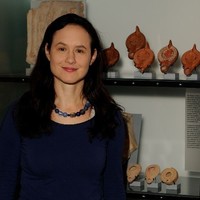
Andreas Rhoby
Phone: +43-1-51581-3432
Address: Austrian Academy of Sciences, Institute for Medieval Research, Dept. of Byzantine Research, Dominikanerbastei 16/4 (postal address Wiesingerstraße 4), A-1010 Wien, Austria / Europe
Address: Austrian Academy of Sciences, Institute for Medieval Research, Dept. of Byzantine Research, Dominikanerbastei 16/4 (postal address Wiesingerstraße 4), A-1010 Wien, Austria / Europe
less
Related Authors
Franz Alto Bauer
Ludwig-Maximilians-Universität München
Anastasios Kantaras
Aristotle University of Thessaloniki
Stefan Albrecht
Leibniz-Zentrum für Archäologie
Donatella Nuzzo
Università degli Studi di Bari
Veronika Scheibelreiter-Gail
Austrian Academy of Sciences
Ilenia Gradante
University of Oxford
Jutta Dresken-Weiland
Georg-August-Universität Göttingen
Alexandra-Kyriaki Wassiliou-Seibt
Aristotle University of Thessaloniki
Manuela Studer-Karlen
Bern University
N. Eda Akyürek Şahin
Akdeniz University
InterestsView All (8)










Uploads
Books by Andreas Rhoby
The volume shows the manifold themes of Greek poetry in Late Antiquity. Pagan and Christian concepts merge in the works of Nonnus of Panopolis and in the “Ekphrasis” of John of Gaza, the poems of George of Pisidia are read against the background of late antique philosophy and the autobiographies of Gregory of Nazianzus as literary forms of expression. The ekphrastic narrative techniques of Quintus Smyrnaeus and the composition of characters in Colluthus are analyzed, and Lycophron is proved as another source of Nonnus’ “Dionysiaka”. The contributions also deal with mythological characters, cyclopes and elephants, and late antique epigrammatic poetry is contextualized in the cultural and literary environment of the time.
https://www.hiersemann.de/verschronik-9783777219028
Papers by Andreas Rhoby
The volume shows the manifold themes of Greek poetry in Late Antiquity. Pagan and Christian concepts merge in the works of Nonnus of Panopolis and in the “Ekphrasis” of John of Gaza, the poems of George of Pisidia are read against the background of late antique philosophy and the autobiographies of Gregory of Nazianzus as literary forms of expression. The ekphrastic narrative techniques of Quintus Smyrnaeus and the composition of characters in Colluthus are analyzed, and Lycophron is proved as another source of Nonnus’ “Dionysiaka”. The contributions also deal with mythological characters, cyclopes and elephants, and late antique epigrammatic poetry is contextualized in the cultural and literary environment of the time.
https://www.hiersemann.de/verschronik-9783777219028
goldsmithing in Byzantine written sources, primarily, with the
addition of archaeological results incorporated in the discussion.
At the beginning, the connotation of gold and derivative
terms in literary sources is mentioned. Hereafter, the question
of the origin of Byzantine gold is discussed. It is not unlikely
that, even in Byzantium, gold mines near Constantinople
were still in use. At the end, professions and names are mentioned
that played a role in Byzantium’s gold workmanship.
Even though gold was scarce in Byzantium, the empire was
able to keep its fame as a »golden realm«.
With contributions by Andreas Rhoby, Paul Hetherington, Olga Shashina, Martin Dennert, Sabrina Schäfer, Anastasios Antonaras, Antje Steinert, Jessica Schmidt, Nikos Kontogiannis, Vana Orfanou, Holger Kempkens, Irina A. Sterligova, Vesna Bikić and Martina Horn.
Please note that this article is published with Brepols Publishers as a Gold Open Access article under a Creative Commons CC 4.0: BY-NC license. The article is also freely available on the website of Brepols Publishers : https://www.brepolsonline.net/doi/abs/10.1484/M.SBHC-EB.5.115586 under this same license.
It gives us great pleasure to inform you that the Lexikon zur byzantinischen Gräzität (LBG) is now accessible online!
The online dissemination of the printed fascicles 1-6 of the LBG is the result of a collaboration between the LBG published by the Austrian Academy of Sciences (Österreichische Akademie der Wissenschaften) and the Thesaurus Linguae Graecae® (TLG®) at the University of California, Irvine.
The LBG is openly accessible online, independent of a TLG licence. Please, visit
http://stephanus.tlg.uci.edu/lbg
Further fascicles will be provided online three years after their printed publication.
Feel free to make extensive use and spread the word!
Erich Trapp and the team of the LBG
for the Promotion of Byzantine Studies
INSCRIBING TEXTS
IN BYZANTIUM:
CONTINUITIES AND TRANSFORMATIONS
18-20 March 2016, Exeter College, Oxford
In spite of the striking abundance of extant primary material – over 4000 Greek texts produced in the period between the sixth and fifteenth centuries – Byzantine Epigraphy remains largely uncharted territory, with a reputation for being elusive and esoteric that obstinately persists. References to inscriptions in our texts show how ubiquitous and deeply engrained the epigraphic habit was in Byzantine society, and underscore the significance of epigraphy as an auxiliary discipline. The growing interest in material culture, including inscriptions, has opened new avenues of research and led to various explorations in the field of epigraphy, but what is urgently needed is a synthetic approach that incorporates literacy, built environment, social and political contexts, and human agency. The SPBS Symposium 2016 has invited specialists in the field to examine diverse epigraphic material in order to trace individual epigraphic habits, and outline overall inscriptional traditions. In addition to the customary format of panel papers and shorter communications, the Symposium will organise a round table, whose participants will lead a debate on the topics presented in the panel papers, and discuss the methodological questions of collection, presentation and interpretation of Byzantine inscriptional material.